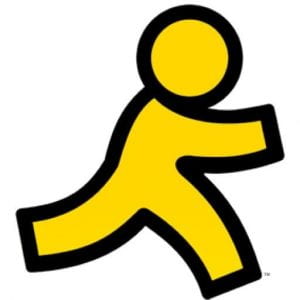The date is December 15, 2017 and an icon in the childhood of many passes away silently without notice…
AOL Instant Messenger (AIM) finally shutters its virtual doors on the tail end of 2017, but the announcement barely makes a blip in the news due to the service already having been on its death bed for years.
The once very popular instant messenger began its prolonged death in earnest in 2011 after the dramatic rise in popularity of SMS messaging and social media plummeted its market share to 0.73%. AIM’s demise seemed a natural part of the seemingly inevitable shift from dedicated instant messaging (IM) services towards other digital writing genres that were rapidly growing as the 2010s began but in actuality it did not end up so.
Before continuing, a moment of silence for the deceased (pictured below).
Research in 2010 by Grabill, et al.’s on “The Writing Lives of College Students” placed instant messaging as the 7th most frequently written genre of writing for college students (just after mostly academic genres). Yet, the same paper show signs indicative that the genre is on the way out in terms of usage and value, which can be seen through college students rating it as the 15th most valuable genre and the close trailing by the just emerging social networking genres just behind it at the 7th and 8th place in frequency. As seen through the demise of AIM a year later, these negative indicators shined true and so began an era in which social media began to dominate (Facebook hits the NASDAQ in 2012 and its billionth user in 2013) and instant messaging became a feature (Facebook messenger, Gmail messenger, etc.) over a dedicated service.
Enter the smartphone, the handheld miracle worker of the 21st century and the savior for instant messaging. Instant messaging apps provided a inexpensive and readily accessible alternative to one of the dominant writing genres of the period — SMS texting (ranked number one in frequency in Grabill, et al.’s research). SMS texting would be surpassed by IM apps in volume of messages in 2013, and two years later a single IM app (WhatsApp) alone would account for more messages daily than SMS texting as a whole, thus the instant messaging writing genre began its climb back towards the top.
Now, not only has instant messaging majorly beat out the former number one (SMS texting), but IM has also beat out the other writing genre which had edged it out years prior with IM apps now holding 20% more active monthly users over that of social networks as of 2020.
Through it all instant messaging has endured, and I believe it will continue to do so for many years more since it is marked by two essential traits in any frequently used genre of written communication — versatility and accessibility.
So, here’s to the the one who all instant messaging apps can thank a lil’ for their existence — thanks AIM.












